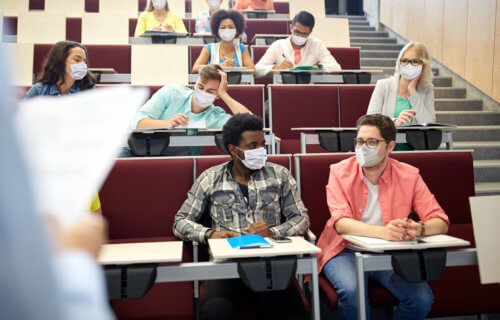New research reveals that cloth masks filter just 10% of exhaled aerosols, with many people not wearing coverings that fit their face properly.
WATERLOO, Ontario — N95 or KN95 face masks may be the best way to avoid COVID-19 during crowded indoor events. That’s the recommendation from a new study reporting most cloth masks just don’t do the job when it comes to stopping the spread of coronavirus within enclosed spaces.
Researchers from the University of Waterloo simulated a person breathing in a large room with a cloth face mask on. Despite wearing a mask, the study finds a large buildup of aerosol droplets suspended in the air. Besides raising awareness on the vulnerability of certain face masks, these findings also emphasize the need for proper ventilation indoors. More ventilation means less of a chance for potentially viral aerosols to linger around.
“There is no question it is beneficial to wear any face covering, both for protection in close proximity and at a distance in a room,” says study leader Serhiy Yarusevych, a professor of mechanical and mechatronics engineering, in a university release. “However, there is a very serious difference in the effectiveness of different masks when it comes to controlling aerosols.”
Studies continue to show that aerosols exhaled by infected individuals can indeed infect others with COVID-19, even if someone is standing more than six feet away.
Why do most face masks fail to offer adequate protection?
Researchers theorize many people wear masks that don’t fit their face properly. As a result, many cloth and surgical masks only filter about 10 percent of exhaled aerosols. The rest make their way past the mask, most through the top, and spread into the surrounding environment. Conversely, higher-quality, more expensive N95 and KN95 masks filter over 50 percent of all aerosol droplets.
In light of these findings study authors recommend that everyone wear a N95 or KN95 mask if possible whenever indoors in the company of others.
“A lot of this may seem like common sense,” Prof. Yarusevych comments. “There is a reason, for instance, that medical practitioners wear N95 masks – they work much better. The novelty here is that we have provided solid numbers and rigorous analysis to support that assumption.”
It’s also worth mentioning that ventilation tests show even modest ventilation rates provide about the same level of protection as the highest quality masks.
The findings appear in the journal Physics of Fluids.

This was a way to avoid panic, nothing more. Don’t insult us by pretending thst these have any chance of stoping a virus that can only be seen under an electron microscope. PLEASE DON’T